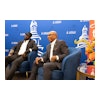Hitting the Books on Instructional TechnologyWhen Ramon Harris weighed the prospect of hiring consultants to teach faculty members and administrators at several historically Black institutions instructional technology strategy and practice, he discarded the idea in favor of another approach — one meant to be less expensive but equally effective as using consultants. That approach took flight in the fall of 1999 when Harris, an executive with the Washington-based Executive Leadership Foundation (ELF), and Dr. Shirley Waterhouse, a Florida-based instructional technologist, began writing a book on instructional technology for higher education institutions.
This past spring, the ELF published A Ten- Step Guide to Establishing Instructional Technology, a 229-page resource guidebook to help administrators, information technology professionals and professors use the Internet, computers and other information technologies in the classroom. The guidebook comes with a CD-ROM.
“What we saw was that there was very little material on helping institutions effectively use technology in the classroom. We recognized that schools had developed their infrastructures, but they needed guidance on taking the next step, which is to enhance the teaching and learning experience,” Harris says.
In May, Harris and Waterhouse, who is director of educational technology at Embry-Riddle Aeronautical University in Daytona, Fla., presented the guidebook during a three-day workshop for officials from 12 historically Black schools. The workshop was part of the ELF’s ongoing Technology Transfer Project (TTP), an initiative that provides information technology assistance to historically Black colleges and universities. Harris, who is director of the TTP, says the project has focused largely on a core group of 13 schools since getting under way in 1999. The foundation is the outreach arm of the Executive Leadership Council, a nonprofit association comprised of leading Black executives at Fortune 500 companies.
The TTP’s core group of schools include Morehouse College, Hampton University, Lincoln University, Bethune-Cookman College, Bennett College, North Carolina Central University, Talledega College, Morris Brown College, Oakwood College, Fisk University, Jarvis Christian College, Wilberforce University and Wiley College.
Terry Jordan, the chief information officer of Wiley College, gives the new guidebook high marks. As one of the attendees at the May workshop, which was held in Atlanta, Jordan found the book highly readable and appealing, particularly given that his expertise is in managing computer networks rather than in designing instructional programs around information technology.
“The book’s written in such a way that it takes into account the perspective that an IT specialist has and that of a faculty member who has no technical background. It takes a holistic approach to instructional technology,” he says.
As an expert in IT systems, Jordan says the book helps him to better understand the teaching and curriculum challenges that faculty members want solved by the technology. He adds that his school is currently training its faculty to use course management software that allows students to access their course schedules and resources through the Internet.
Harris notes that although the guidebook was developed to serve its Black college constituency it has been written with generic content to be applicable to any higher education institution. Since its first printing run of 1,000, a copy of the guidebook has been sent to every HBCU president, according to Harris. The TTP plans to hold workshops featuring the guidebook’s contents for another 40 HBCUs over the next year.
To date, Harris estimates the guidebook has cost $100,000 to produce and market. The guidebook is being sold to officials based at HBCUs at a discounted rate of $49.95. Non-HBCU buyers can purchase it for $74.95. Harris says he is optimistic that the guidebook will find an audience beyond the HBCUs served by the TTP.
“We’re getting a fair amount of general sales,” he says.
Russell Garth, the executive vice-president of the Council of Independent Colleges, which is based in Washington, says small to mid-sized colleges and universities need considerable guidance on getting the most out of instructional technology. Although he has not read A Ten-Step Guide to Establishing Instructional Technology, Garth says such a guidebook can be highly valuable to schools.
“There is a need. Institutions are struggling to make their IT infrastructure pay off in the classroom,” Garth says.
© Copyright 2005 by DiverseEducation.com



















